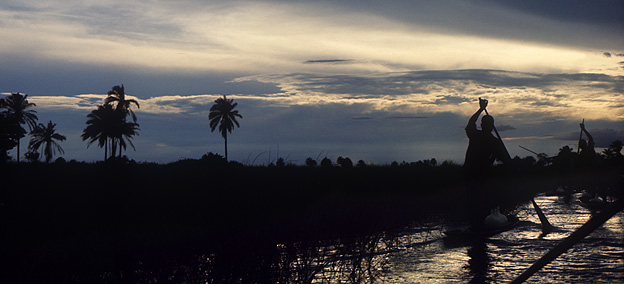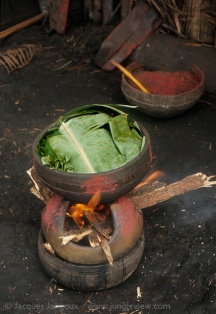(part 1: THE ISLAND VILLAGES) Although the Libinza live in villages, water is ever present. Transportation is by canoe, subsistence is mostly fishing. Since the earlier age children now that water is their environment.

Boys of Libinza tribe playing in canoes. The Libinza live on the islands of the Ngiri River, tributary of the Ubangi River, Democratic Republic of the Congo, Africa.
The grasslands.

Woman with children in canoe in swamp savanna, going to swamp forest to fish and collect drinking water.
From the swamp grasslands to the swamp forest.
Children in traditional non-literate societies learn by partaking in adult activities. Now children go to school (2nd picture from top) but the traditional ways persist.
Women fishing
Both nylon nets (above) and traditional fish traps are used for fishing.
Esoko fish trap (Piège esoko).  Illustration from: Welcomme, R.L., River fisheries. FAO Fish. 1985 Tech.Pap., (262): 330 p. CHAPTER 7 THE FISHERY (Scroll down to Fishing Gear)
Illustration from: Welcomme, R.L., River fisheries. FAO Fish. 1985 Tech.Pap., (262): 330 p. CHAPTER 7 THE FISHERY (Scroll down to Fishing Gear)
Pierre Van Leynseele: “Le moleke … est une nasse faite de lames de bambou (mbenge) reliées par de la corde de raphia. Le moleke, dont la taille varie, a la forme d’un cône aplati au sommet… Le piège esoko est très répandu dans toute la zone du confluent. Il est fabriqué de Ia même manière que la nasse moleke, mais il est conique, démuni de chicanes et ne mesure qu’une cinquantaine de centimètres. L’ouverture se ferme au moyen d’un clapet de même fabrication, commandé par une corde de raphia. Celle-ci est fixée à une tige souple tendue comme un arc et qui prolonge 1a pointe de la nasse. A l’intérieur de celle-ci se trouve l’appât, un fruit de pa1me, qui est fixé à un dispositif fort précis qui déclenche la fermeture du clapet. L’esoko est utilisé encore maintenant et en très grand nombre, par les hommes et les femmes, à proximité ou dans ta forêt inondée. Les Libinza 1’utilisent beaucoup moins que les gens de la Haute Ngiri comme les Bamwe, Djando ou que les gens de la forêt comme les Balobo.” The Libinza have devised a clay pot hearth, which allows cooking in the canoes while in the swamp forest. These hearth pots are also used in the villages.
Men collecting and drinking palm wine
A rainy day…
Contact for quote or Purchase photographs online
End of trip.
I had arrived in the Congo at Kinshasa, and from somewhere upriver (I started taking notes only after arriving in the Libinza region, and I don’t remember the beginning and some of the end of the trip) I went to a Libinza village, Liketa, in Pierre Van Leynseele’s motor boat. He then followed to the groups he studied, leaving me at Liketa. At the end of my stay with the Libinza, I went on a 3-day canoe trip to a town downriver, Bomongo. For some reason I had decided not to travel back through Kinshasa, but instead to go to Bangui in the Central African Republic, from where I would get a flight to Paris and a connection to Brussels. To get to Bangui I had to go first to Impfondo in the Republic of the Congo (Congo-Brazzaville), then under a communist regime, to wait for a boat going up the Ubangi river. Upon arriving in Impfondo I was quickly led to the mission, where the father told me to stay until the boat arrived so as not to be seen, because Europeans were not welcome by the civilian governor (although he told me that there would be no problem with the military commander). So I had a few days of anxiety… I did not look forward to a second experience of the hospitality in an African jail .
Bibliography (2)
Pierre van Leynseele: Les Libinza de la Ngiri: l’anthropologie d’un peuple des marais du confluent Congo-Ubangi: now found only in university libraries, will be published by Éditions L’Harmattan.
The future…
The WWF has plans to establish a reserve in the lower Ngiri region, which would not take into consideration the highly effective management of the environment by the Libinza (this would be downstream from the region that I photographed and that Pierre Van Leynseele studied); local populations are worried: Equateur – La nouvelle réserve naturelle inquiète les riverains L’ICCN (Institut congolais pour la conservation de la nature) declares: “Il ne s’agira pas de chasser les habitants de leur milieu de vie. Une fois le niveau de conservation amélioré, les gens trouveront du poisson et mangeront du gibier, affirme le responsable provincial. Bien plus, leur condition de vie sera améliorée, des emplois seront créés lorsque les touristes vont commencer à affluer.” So an auto-sufficient traditional culture, with an efficient environment and conservation management that has maintained the habitat for centuries, would be replaced by a culture subservient to the needs of wealthy tourists…













